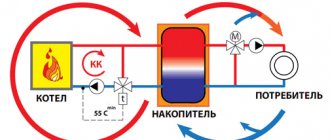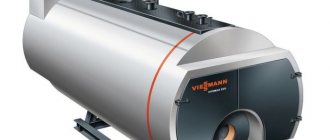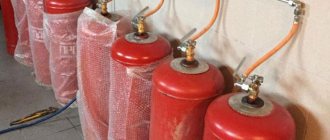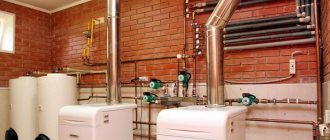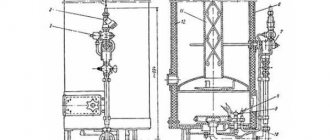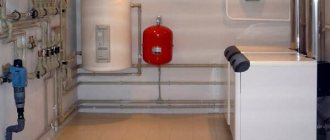Despite the fact that an induction boiler costs 2-3 times more than its heating element counterpart, an increasing number of users prefer this type of heater. Thanks to its simple and trouble-free design, the unit is durable and maintenance-free. Due to the high power, the connection of the installation must be coordinated with the Distribution Zone.
The induction boiler has a safe design.
The history of the appearance of heating equipment
The prerequisite for the creation of heat generators of this type was the discovery of electromagnetic induction made by Michael Faraday on August 29, 1831. Before him, this phenomenon was observed by Francois Jean Dominique Arago, but could not explain and reveal it.
Induction is the occurrence of an electromotive force in a closed conductor when the magnetic flux passing through it changes.
This can be achieved in 2 ways:
- Varying field parameters. To do this, change the strength or direction of the current flowing in the electromagnet coil.
- The movement of the conductor relative to the field or vice versa. To do this, for example, a permanent magnet is rotated.
Later, this phenomenon was studied in detail by Jean Bernard Foucault. He called volumetric currents arising in a material under the influence of an alternating magnetic field eddy currents. This is due to the circular trajectory of the charges. They are also called Foucault currents, named after the researcher.
According to the Joule-Lenz law, electricity induced by a magnetic field causes an increase in the temperature of the conductor. E. Colby took advantage of this in his experiments on non-contact heating of steel. In 1900, in the Swedish city of Jaising, she built the first induction melting furnace with a power of 78 kW. The project manager was engineer F. Kjellin.
In 1900, the first induction melting furnace was built.
Subsequently, the technology was developed and began to be used to solve a wide range of problems, in particular:
- ultra-pure smelting, soldering and welding of metals;
- bending and heat treatment of machine parts;
- creating jewelry;
- disinfection of medical instruments;
- heating miniature workpieces that are at risk of damage when in contact with gas-flame and arc equipment;
- surface hardening, including products of complex shapes;
- activation, training and degassing of cathodes in the production of vacuum electronic devices.
Due to the large size of the first installations, this method was not initially used in everyday life.
Later they began to produce:
- kitchen stoves;
- water heaters;
- heat generators.
Comparison of induction boiler with heating element boilers
equivalent
The heating rate of the same volume of coolant by boilers of these types of electrical energy-to-heat converters of equal power consumption is also the same.
An induction boiler has many operational advantages because it has a much larger area of heat transfer to the coolant than in a heating element boiler.
Main differences:
- The difference between the temperature of the heating element of the induction boiler and T* of the coolant is 10 - 15* C and they heat up together. There is practically no scale formation on the heating element of an induction boiler. For this reason, its heating element cannot even theoretically fail.
- The heating element heats up because current flows through its conductor with increased resistance, so in any case it heats up to the specified 600 - 750 * C and the coolant on its surface always boils. Because of this, the heating element quickly becomes overgrown with scale. As a result, heat transfer decreases, and the heating element eventually burns out.
- In an induction boiler, you can use different coolants, even petroleum products, if they are not overheated above 70* C.
- In heating element boilers, only water can be used as a coolant and, moreover, distilled water is best.
- In maintenance, heating element boilers are less practical than induction boilers, because the transition contact between the power supply conductor and the conductor of the heating element itself is constantly overheated, and as a result is oxidized and weakened. It is necessary to constantly ensure that the power supply conductor does not burn out; otherwise, when burned out, the threaded connection of the heating element may be damaged; and such a working heating element has to be changed. This problem does not exist in induction boilers, because the connection of its heating element with the power supply is carried out through the electromagnetic field of alternating current.
- Induction boilers can be installed in any place, even not in a separate place. They are fireproof and operate silently.
- Induction boilers provide human electrical safety much higher than heating element boilers, because the heating element itself can burn out in two ways: a) with depressurization of the housing; in this case, heated nichrome crumbles when water hits it - there is no danger of a person coming under voltage; b) without depressurization of the housing; in this case, heated nichrome may stick to the body of the heating element. The heating element continues to work, and through the water the metal body of the boiler becomes energized.
- It is not yet possible to make the induction coil of an induction boiler with powers of 3 kW or more at 50 Hz small and compact. Therefore, the heating element boiler has much smaller dimensions at the same power than an induction boiler.
General information about induction heating boiler
The production of such units began in the 90s. last century. Many models are cylindrical in shape, so they fit well even in small spaces.
Purpose of the inverter
The most expensive models are equipped with an electrical converter that processes the mains current as follows:
- straightens;
- again makes it variable with a frequency of up to 80 kHz instead of the standard 50 Hz.
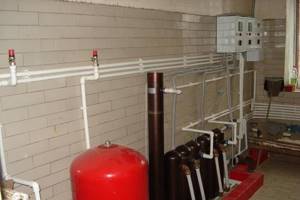
Inverters are equipped with an electrical converter.
At the first stage, a simple diode bridge is used. On the second there is a circuit of fast-acting key transistors and a microprocessor that controls them.
Increasing the frequency of the current leads to a similar change in the magnetic field it generates. As a result, the so-called skin effect. It consists in the fact that due to the interaction of constantly changing primary and secondary fields, free charge carriers are displaced into the surface layers of the product. As a result, the current density increases, and hence the heating intensity, since, according to the Joule-Lenz law, these quantities are interrelated:
ω = j*E.
The temperature deep within the material increases due to thermal conductivity. As the frequency of the inductor's magnetic field increases, the layer thickness decreases. As a result, the current density increases.
Specifications and functionality
The device passport indicates the following parameters:
- power;
- voltage – 220 or 380 V (1- or 3-phase);
- dimensions and weight;
- installation method - wall or floor;
- highest coolant temperature;
- maximum pressure in the tank.
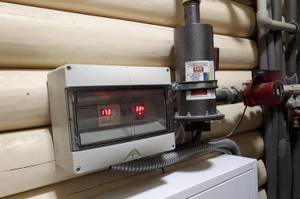
The induction boiler has a high efficiency of up to 99%.
Often referred to as efficiency. But this is a marketing ploy - any electric boiler, regardless of its operating principle, operates with 99% efficiency.
The weight of a 15 kW unit is 15 kg (Comfort brand unit), 5 kW – 11 kg (ELC Indukcion).
Functionality:
- Smooth launch. This eliminates sudden voltage fluctuations in the home network.
- Power adjustment within a wide range. For example, a heater with a nominal capacity of 6 kW has 3 stages of 2 kW each.
- Maintaining the coolant temperature within user-specified limits. The device automatically selects the desired mode and turns off if necessary.
- Programming. The user sets the heater operating schedule for each day of the week. For example, on weekdays from 8-00 to 17-00. When no one is home, the coolant temperature is set to a minimum.
- Room thermostat. Using a remote sensor, the device monitors the air temperature in the room and selects the optimal operating mode.
- Weather-compensated control. Some models also monitor the outside temperature and adjust performance ahead of time when it changes. This avoids wastage of energy.
- Remote control. The GSM module allows you to turn on the device and change its settings from your smartphone.
- Display of operating parameters on the screen. There are models with a touch screen.
The double-circuit unit additionally provides hot water supply in flow mode.
Many models are equipped with an expansion tank and pump.
Device
The device consists of the following components:
- Housings with thermal and electrical insulation.
- Boiler tank with core.
- A coil of wire wrapped around it, filled with a compound.
- Automation block.
- Terminal box for cable connection.
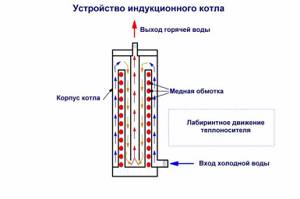
Installation of an induction boiler.
Principle of operation
The operation of the boiler is based on the induction effect. Part of the work done by electric current is spent on creating a magnetic field around the conductor. If it is assembled into a coil, this share increases many times over. Thus, the boiler winding acts as an electromagnet-inductor that generates an alternating field.
It induces Foucault currents in the heat exchanger and core, thereby causing them to heat up.
Device and principle of operation
The main element of an induction boiler is a transformer with a toroidal winding. The device of such a boiler itself consists of the following elements:
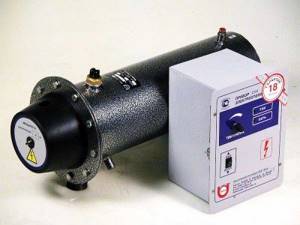
- The body of the unit, which is made of metal.
- A layer of electrical protection and thermal insulation.
- The core is a ferrimagnetic tube.
The core winding acts as the primary winding, and the secondary winding is the boiler body. Also included in the package:
- Circuit breakers.
- Temperature sensor, which is built into the boiler body.
- Electronic thermostat.

Not only ordinary water and antifreeze, but also oil can act as a coolant in such a system.
Operating principle
The name induction electric boiler contains the principle of its operation - electromagnetic induction. When voltage is applied, the following processes occur:
- An electromagnetic field is created.
- The core heats up to a temperature of 750 °C.
- The coolant enters through special pipes and, passing through the core, heats up, then transferring the heat to the heating radiators of the house.
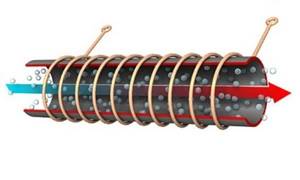
This heating method allows you to heat a large volume of coolant in a short period of time. At the same time, the convection currents created make it possible to do without a circulation pump.
Advice! The absence of a circulation pump is justified in small heating systems. When heating a two-story house with an induction boiler, its presence is mandatory.
Main types
Different types of boilers differ in the design of the heat exchanger:
- Casing. The device consists of 2 parts located inside and outside the coil.
- Volumetric or inductive-conductive. The boiler tank is located inside the winding and contains a ferrite core.
- Tubular. The first induction heaters belonged to this type. The heat exchanger is a set of pipes that go around the winding.
The units are also divided into models with and without an inverter.
Operating principle and design of an induction heater
Induction is a physical phenomenon based on eddy currents, which was discovered and studied by the French physicist J. B. L. Foucault. Induction boiler equipment uses Foucault currents in its operation, operating on the principle of electromagnetic induction.
An alternating voltage is supplied to the coil, an electromagnetic field is formed, which provokes the appearance of eddy currents that heat the metal. Water is heated in a heat exchanger and, circulating through the system, heats the premises in a private house.
Modern induction-based heating units consist of the following elements:
- heat exchanger or core;
- terminal box;
- inductor;
- control cabinet;
- conductors;
- inlet and outlet pipes.
For ease of operation of the equipment, additional elements may be included in its design. Essentially, this type of boiler is an inductor, which is placed in a small but very heavy iron alloy housing.
In this case, instead of a core, in some devices a regular metal tube with coolant is mounted. However, the presence of a core increases the heat transfer area.
Such a system has a high degree of reliability, since the induction coil is firmly sealed in a sealed housing without direct contact with the coolant. The occurrence of holes in the coils is almost impossible, since they are not wound too tightly, and in addition they are filled with a special insulating compound.
All this is enclosed in a thick-walled, massive body, which guarantees a long service life. Manufacturers provide a guarantee of 5-10 years, but sellers of boiler equipment claim that an induction electric boiler can last about 30 years without maintenance.
Main advantages of use
Compared to heating elements, non-contact heating boilers have the following advantages:
- Resistant to voltage surges. They can even withstand lightning strikes and zero ground breaks.
- Reliability and durability. These qualities are due to a simple design: the working part of the boiler consists of a pipe and a wire wound around it.
- Heat exchanger tightness. Its integrity is not compromised, so leaks are excluded.
- No scale. According to the manufacturers, it is not formed due to microvibrations of the heat exchanger walls.
- Large heating surface area. It is multiple times higher than that of the heating element. This ensures rapid heating of the coolant.
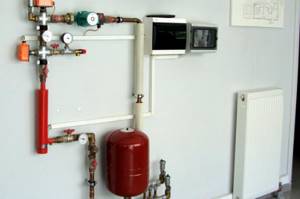
The induction boiler is resistant to voltage surges.
Compared to gas, solid fuel and diesel analogues, induction is superior because:
- Does not produce exhaust and does not require a chimney.
- It works silently.
- Able to regulate power over a wide range and at high speed.
- Due to the absence of fire, it is not a fire hazard.
- It is equipped only with electronic automation, which means it has all modern functions - programming, weather control, etc.
Advantages and disadvantages
The advantages of induction heating include the following facts:
- No scale is formed.
- There is no burning, no soot, no storage space required.
- No chimney needed.
- Long service life without loss of characteristics.
- The device has a modest size despite its considerable power.
- Heats up the coolant faster than other electric analogues.
Even though scale does not form on the boiler parts, it is still recommended to go through it every two years to inspect and carry out maintenance.
Minuses:
- Electricity bills will be considerable.
- The cost of the boiler itself is more than that of a heating element (although a homemade one will be cheaper).
- Controversial environmental friendliness.
A person using electricity for heating may think that he is not harming the atmosphere. But in order to generate electricity, it was necessary to burn coal somewhere far away in a power plant, build a dam, or split an atom.
Criteria for choosing a good boiler: what to look for
When purchasing a unit, consider the following:
- Power. For a standard house, 1 kW is required for every 10 square meters. m area.
- Voltage. The 380 V model is suitable only for those who have 3 phases connected to their house.
- Maximum pressure in the boiler tank. It must withstand the load from the pump and the weight of the water column.
Models with several power levels are preferable - when starting, they do not cause a sharp drop in voltage in the network.
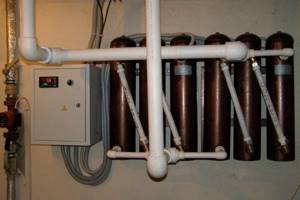
When purchasing a unit, consider the power and voltage.
Due to the high cost of electricity, it is recommended to choose a boiler with functions that allow you to use energy economically:
- with weather-compensating automatic;
- programmable.
Help in choosing a boiler
Due to the novelty of such equipment, only two brands are represented on the domestic market:
- VIN – . This vortex heater (this is what the abbreviation stands for) consumes converted high-frequency voltage. At the exit from the coil, this gives a sharp jump in the EMF intensity and an increase in Foucault surface currents. This allows the body and all internal parts, which are specially made of a special ferrimagnetic alloy, to almost instantly heat up and transfer thermal energy to the coolant. We can say that all the structural components of the unit act as one heat exchanger, this explains its high efficiency.
- SAV – . This induction boiler consists of a short-circuited labyrinth of coolant pipes, which acts as a secondary winding. The alternating current generated in this winding makes it possible to quickly heat the surface of the heat exchanger. Thanks to the branched labyrinth of pipes in the heat exchanger, the coolant passing through it quickly heats up, which explains the high efficiency of this type of boiler. Thanks to the law of self-induction, the new generation device allows the coil to independently induce the necessary reactive power. This allows this type of induction boilers to be used in power networks with low voltage, which gives tangible results when working in rural areas with weak electrical substations.
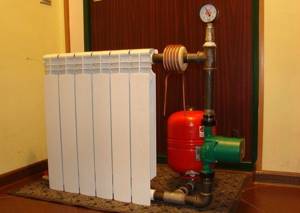
All induction electric boilers differ in power and number of connection phases:
- Single-phase: power 2.5–7 kW.
- Three-phase: power 7–60 kW.
In addition to standard automation (automatic circuit breakers), the induction boiler can be equipped with an electronic programmer. This device allows you to set the boiler operating mode for the whole week, and, if necessary, carry out adjustments remotely via a GSM channel.
Boiler power calculation
To calculate the system power as accurately as possible, it is necessary to invite specialists. But you can easily make an approximate calculation, which will be quite sufficient. To do this, for every square meter of heated area there must be 60 W of boiler power.
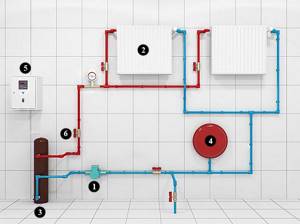
This power is quite enough, because the efficiency is very high and does not decrease during operation.
Advice! When choosing an induction boiler, it is necessary to clarify the thickness of the core walls. The optimal thickness is 10 mm. Such a core guarantees long and uninterrupted operation of the home heating system.
Review of popular manufacturers and models
More and more companies are mastering the production of induction boilers. Some brands have become especially popular.
VIN
The brand belongs to the “Alternative Energy” thermal equipment plant. The company produces induction-conduction heaters with volumetric heat exchangers. All boilers are equipped with inverters. The cost is 37-40 thousand rubles.
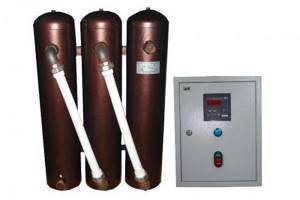
VIN - heater with a volumetric heat exchanger.
SAV
Equipment of this brand is produced by NPK INERA.
Peculiarities:
- shell heat exchanger;
- lack of inverter.
The devices operate at a standard network frequency of 50 Hz. Because of this, they are larger than inverter ones, but cost less - 27-32 thousand rubles.
"Geyser"
The brand belongs to the Kostroma Boiler Equipment Plant. The company produces a series of heaters with a rated power of 5, 10, 15, 20, 25, 50, 100, 250 kW. The first requires a voltage of 220 V, the others - 380 V.
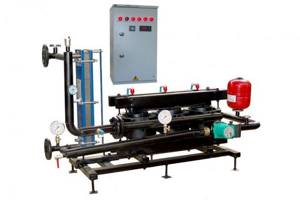
Geyser units are of the inductive-conductive type.
All units are of the inductive-conductive type.
"Edison"
The model range of this brand includes heaters with a rated power of 4.7, 13, 22, 50, 100, 250, 500 kW.
The most productive installation is capable of heating an object with an area of 5000 square meters. m. Its weight is 1.5 tons.
The minimum price for Edison products is 35 thousand rubles.
The models are not equipped with inverters, so the youngest representative of the line weighs 40 kg with a power of 4.7 kW.
"Miratron"
The company offers several induction heaters with capacities ranging from 6 to 30 kW. The company uses only high-quality materials in the manufacture of units. All of them have a connector for connecting a weather sensor, and a programming function is provided.

"Miratron" is an induction heater made of high-quality materials.
A 6 kW model costs 45 thousand rubles, a 15 kW model costs 65 thousand rubles.
Features of self-installation and operation of homemade boilers
As in the case of factory-made boilers, only a closed-type heating system can be suitable for installing a homemade induction installation. It should include a centrifugal pump, which creates constant circulation of the coolant inside the heating system. The plastic pipelines that are common today are ideally suited for installing a homemade induction boiler. All regulations related to the installation of store boilers must be fully observed in this case. If you install controls and safety devices on the system, then your homemade installation will be little inferior to its factory counterparts.
Although it is quite difficult to make such a device, and it is better not to take on this task without having “direct hands”, it is a pleasure to operate it. After all, along with ease of use, we also get serious energy savings.
DIY methods
Thanks to a simple device, you can make a small induction heater yourself.
The easiest way is to install an electromagnet next to the cast iron battery. Home craftsmen also assemble more efficient designs.
From a welding inverter and plastic pipes
This is the most common option.
Proceed in the following order:
- Take a piece of thick-walled plastic pipe DN50 0.5 m long. Most often, a product made of polypropylene is used.
- Using a special heater, weld the coupling on one side, after inserting a circle of metal mesh into it. The part must completely cover the end of the pipe.
- Pour scraps of stainless wire 7 mm thick and up to 5 cm long into the water heater. They will serve as a core.
- Cover the second end of the pipe with a metal mesh and weld the coupling.
- Wind 90 turns of enameled copper wire around the body. This is an inductor coil.
- Connect a 15 A welding inverter with a smooth current control function to the wire.
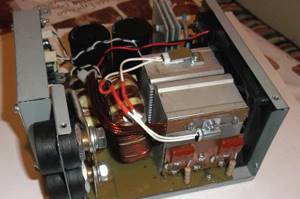
The device can be made from a welding inverter.
It is permissible to replace couplings with fittings with metal threads.
The heater is ready, you can connect it to the pipeline.
Let's start working!
So, to make homemade induction heating boilers, you must first collect everything you need:
- Tools;
- Wire rod or steel wire with a diameter of up to 7 mm;
- Copper wire;
- Thick-walled plastic pipe;
- Metal mesh;
- Inverter welding machine.
To make a housing for our boiler, you need to either buy or find at home a thick-walled plastic pipe with an internal diameter of 5 cm. Such a pipe will not only serve as the basis of the induction coil, but also be a section of the heat pipe.
The heating diagram, which is best placed in front of your eyes, will also help you a lot. Based on such a diagram, you can determine additional characteristics of the device.

Induction boiler diagram
Pieces of steel wire, cut to a length of about 5-7 cm, will be heated in an electromagnetic field. Their diameter should not be more than 7 millimeters.
You will also need special adapters; these are the ones that will connect your boiler to the pipe system. On the one hand, the coolant will go in in a cold state, and on the other, it will come out warm using induction.
When you make induction heating boilers with your own hands, the first adapter must be welded, and the second one can simply be threaded.
The entire internal space in the pipe is filled with cut pieces of wire. After this, the device must be securely closed on both sides.
To make an induction coil that will serve as the main heating element, you should prepare enameled copper wire. We wind approximately 90-100 turns onto the plastic body, but the same distance must be maintained between sections. When we have assembled such a homemade inductor, we need to connect it to the system. Such a boiler can be installed anywhere in the pipeline.
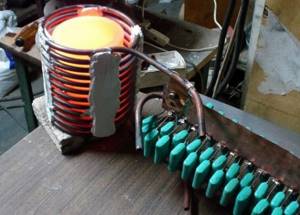
Homemade induction boiler at work
The coil is connected to the high-frequency inverter. Remember that under no circumstances should you turn on such a device if there is not enough heat carrier inside it! After all, the plastic case can simply melt due to high temperature.
So, an induction boiler made by yourself is almost ready. You just need to ensure its operation is safe. To do this, we must insulate all open areas of copper wire with special materials that have good thermal and electrical conductivity.
Inverter heating boilers
Self-installation instructions
When installing the device between it and building structures, maintain the following minimum distances (cm):
- walls – 30;
- floor and ceiling – 80.
The device is leveled in a strictly vertical position.
Connecting the boiler to the heating system
Induction heaters are intended only for closed circuits with forced circulation of coolant.
There are 2 reasons for this:
- high hydraulic resistance;
- high heating rate - the medium boils before it has time to escape into the system under the influence of convection.
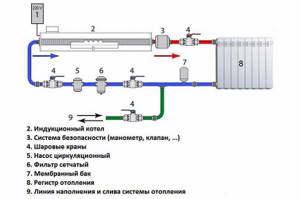
Induction boiler connection diagram.
Therefore, the circuit must be equipped with:
- Circulation pump with mesh filter. It is connected to the boiler on the “return” side.
- Diaphragm expansion tank. Placed right there.
- Safety group consisting of a pressure gauge, air vent and safety valve. It is installed on the “supply” side no further than 0.5 m from the boiler without any fittings in this area.
The “return” is connected to the heater from below. “Feed” – to the upper pipe.
Electrical connection
The device is supplied with its own cable from the distribution board. The cross-section of the conductors is selected according to the amount of current consumed. The line is protected by a circuit breaker and an RCD. The boiler body is grounded.
Principle of operation
As you know, metal located in a magnetic field heats up. And if this piece of iron is placed in a water heating circuit, then the coolant circulating through the pipes will take the temperature from it.

Operating principle of the SAV induction boiler
An induction boiler heats up the room faster, but this does not mean that it is more economical than its heater counterpart. Their efficiency is the same.
Operating rules and maintenance
Do not do the following:
- Fill the system with a coolant that is not listed as permitted by the manufacturer.
- Turn on the device in dry running mode or with the pump stopped.
- Carry out repair or maintenance work without turning off the power to the unit.
- Keep metal objects near the heater.
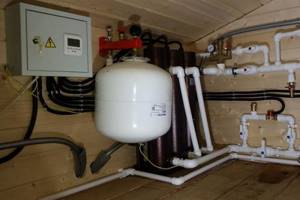
The device cannot be turned on in dry code mode.
Check periodically:
- performance of the RCD;
- ground loop resistance.
Induction heaters do not require maintenance. In rare cases, the heat exchanger may become covered with scale, then it is washed with a solution of citric acid or a special product. To eliminate such phenomena, fill the system with demineralized water.
Approximate cost of induction heating for a private house
In rated power mode, the boiler operates only a small part of the time - when the outside temperature drops to extremely low values. In a building built in accordance with energy saving standards, the average performance of the heat generator for the entire cold season is 1/3 of the maximum.
Let the area of the house be 150 square meters. m. Then:
- rated power of the device at the rate of 1 kW per 10 sq. m – 15 kW;
- the average for the heating season is 5 kW.
If the duration of the cold period is 7 months (213 days), the total energy consumption is equal to:
Р=5*24*213=25560 kW*h.
The cost of 1 kWh in rural settlements, for example, the Samara region, as of the first half of 2021 is 3.02 rubles.
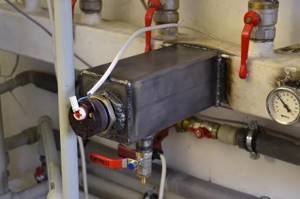
The costs for an induction boiler will be high.
Heating costs will be:
Z=25,560*3.02=77,190 rub. for 7 months or 11,027 rubles. for 1.
Of all types of heating, electric is the most expensive.
To reduce costs, proceed as follows:
- Switching to a 2-part tariff. For villages and hamlets of the Samara region. the price of 1 kWh at night in 2021 is 1.66 rubles.
- A heat accumulator is installed in the heating system. This is a large container encased in mineral wool.
The boiler operates only at night, heating the liquid in the storage tank to +95°C. During the day, the heating circuit, as needed, selects hot water from the tank through a mixing unit.
The costs in this case will be:
Z=25,560*1.66=42,430 rub. for 7 months or 6061 rub. for 1.
In this scheme, the boiler works at night simultaneously on the heating system and on the battery. Therefore, we need a model with 2 times the power - 30 kW.
Examples of homemade designs
Homemade heaters are mounted on small radiators that can be moved if necessary; they do not even require a circulation pump.
Another option is an induction boiler mounted parallel to the main heating boiler. The system already has a circulation pump. Installed vertically.
The electromagnetic induction method is widely used in industry. Gradually, the technology moved into the household sphere. Devices operating on the induction principle can be found in stores more and more often. Induction water heater - design features, advantages and disadvantages, read on.
You may be interested in learning about what quartz heaters are and why they are good. Read about it here.
Despite the fact that gas is replacing all other types of heating sources, wood stoves still remain in demand. In this topic https://microklimat.pro/otopitelnoe-oborudovanie/pechi/drovyanye-dlya-doma.html you will find out which wood-burning stove is better - metal or brick. Let's also look at the pros and cons of stove heating.
Negative sides of boilers
The disadvantages of induction heaters are:
- High price. The device costs 2-3 times more than its heating element counterpart.
- Large weight and dimensions. Household models generally weigh from 40 to 80 kg.
- High cost of energy resources. In Russia, the average cost of an electric kWh is 3.5 rubles, while that obtained from burning main gas is only 0.5 rubles.
- Difficulty connecting. According to the standards, only 5-7 kW is allocated for an apartment and a house; if there is an electric stove, it is 88-11. To increase the limit, you need to obtain permission from the Distribution Zone and replace the supply cable. There have been cases when, in order to connect a 15 kW boiler, people had to pay for the replacement of a transformer at a substation.
Expenses
The costs of making a boiler will consist of the cost of materials and tools (it’s good if most of them are already in stock):
- Pipes on the base of the device.
- Wires for winding the induction coil.
- Soldering iron for plastic pipes.
- Welding transformer.
Induction boilers are classified as “elite” heating devices.
Not everyone can pay for their monthly consumption. Of course, a lot depends on:
- house size;
- boiler power;
- insulation of premises;
- desired temperature and weather outside the window;
- cost of electricity in the region.
Approximate calculations say that a 2 kW boiler will spend about 4,000 rubles. per month.
5 kW of power will cost about 10 thousand rubles.


